Physical Address
304 North Cardinal St.
Dorchester Center, MA 02124
Physical Address
304 North Cardinal St.
Dorchester Center, MA 02124
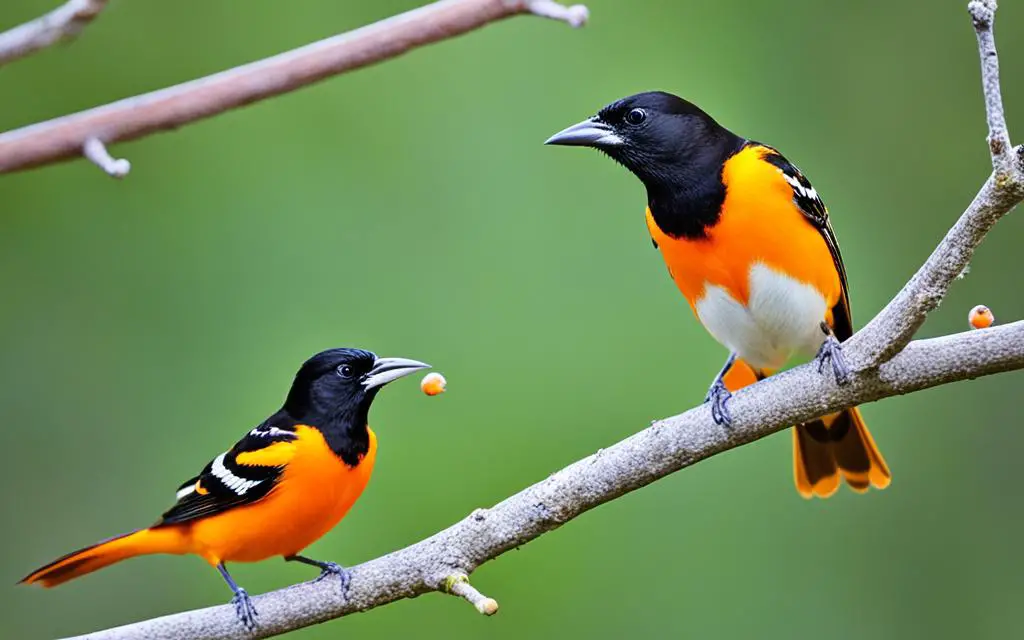
If you’re an enthusiast aiming to attract stunning birds to your garden, understanding how to choose the right oriole feeder may be the key to transforming your backyard into a birder’s paradise. These vibrant visitors, with their striking black and orange plumage, are a majestic sight to behold. Yet, charming these elusive songsters to your slice of the great outdoors involves more than just luck. It requires forethought and a strategic approach rooted in their unique preferences.
Your journey into backyard birding can be greatly amplified by selecting equipment that resonates with the orioles’ needs. Assembling your space with the best oriole feeder, employing oriole feeder buying guide know-how, and adhering to best oriole feeder selection tips will ensure that these delightful creatures grace your garden with their presence. So, let’s gear up for a season of feathered festivity by exploring the essential criteria for a feeder that wins the hearts – and appetites – of orioles.
As a birder, your ability to spot a vibrant Baltimore oriole or a perched orchard oriole depends on your knowledge of the species that frequent your locale. With nine oriole species in the United States and five widespread, learning to identify these avian visitors by their habitat range and migratory trends is an exciting challenge. Whether it’s the stunning image of a Baltimore oriole bird that captivates you or the less frequently seen Scott’s oriole bird, each has a preferred environment and travel schedule, shaping their behavior and feeder visits.
Visitors to www.allaboutbirds.org can discover a wealth of information on identification and habits, providing valuable insights that can inform decisions about the type of feeder and food to offer. Remember, recognising the oriole species in your area is key because each has its distinctive features and dietary needs. With these insights at your disposal, attracting these elusive creatures to your backyard becomes a more attainable delight.
| Oriole Species | Region | Feeder Preferences | Migration Period |
|---|---|---|---|
| Baltimore Oriole | Eastern & Central US | Nectar, Fruit, Jelly | Spring to Late Summer |
| Bullock’s Oriole | Western US | Fruit & Insects | Spring to Early Fall |
| Orchard Oriole | Eastern & Midwestern US | Insects & Nectar | Late Spring to Early Summer |
| Hooded Oriole | Southwestern US | Nectar Feeders & Small Insects | Spring to Fall |
| Scott’s Oriole | Southwestern US | Nectar & Jelly | Spring to Late Summer |
Understanding the nuances between these species—from the Baltimore and orchard orioles’ similar haunts to the Scott’s oriole bird’s penchant for nectar—helps you create a welcoming environment. Spotting a beautiful oriole can be as much about the tactical placement of the right type of feeder as it is about the thrill of the search. Enhancing your oriole knowledge means you’re not just waiting for a fleeting glimpse; you’re inviting them into your world with open arms.
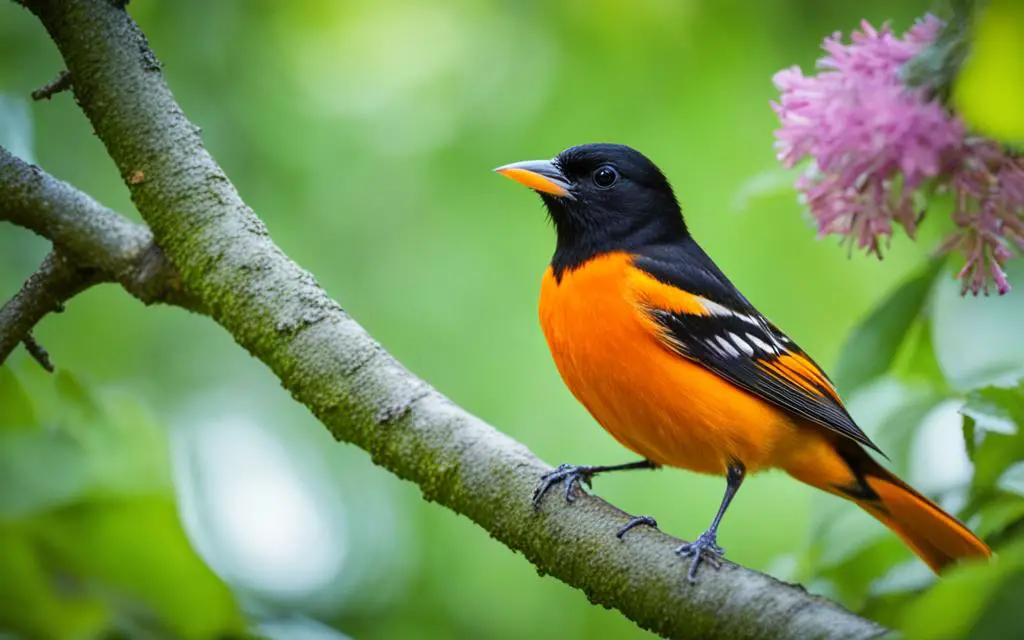
When it comes to attracting orioles to your backyard, the right feeder can make all the difference. Varieties exist to cater to the oriole’s dietary preferences, whether they seek out sugary sustenance or natural fruit offerings. Understanding the different oriole feeder types and their respective benefits is essential in providing a hospitable environment for these colorful visitors.
Nectar feeders are particularly effective during the early months of orioles’ return from migration, offering the high-energy sugar water these birds crave. However, unlike their hummingbird counterparts, orioles can’t hover to feed. Providing nectar feeders with perches allows these birds to comfortably dine, making your backyard a go-to spot. It’s important to choose feeders that are not just attractive but also easy to clean, minimizing the risk of mold and bacteria.
Another flavorful option is grape jelly, a treat that satisfies the orioles’ sweet tooth, especially during the demanding springtime. Jelly feeders designed to prevent mess and deter pests like ants will keep these singing beauties happy and healthy. Accessibility is key, ensuring that the sticky treat remains a delight rather than a nuisance, encouraging orioles to return for more.
Orioles have a natural inclination towards fruit, and fruit feeders that enable you to offer fresh orange slices or other fruit can be irresistible to these birds. Many oriole aficionados utilize feeders equipped with skewers or pegs designed for this purpose, reflecting the birds’ natural eating habits. Durability and the feeder’s ability to be easily hung are crucial, providing a secure and long-lasting dining option.
As you seek to create a paradise for your feathered guests, consider incorporating oriole feeder types that offer multiple feeding options. This approach ensures that whether they are in the mood for the sweet draw of nectar, a jolt of energy from jelly, or the appealing taste of fresh fruit, your backyard will cater to all their needs.
When you’re on a quest to host orioles in your garden, sifting through oriole feeder comparison charts and scrutinizing oriole feeder reviews can be your most informative allies. Not all feeders are created equal, and the right choice can significantly impact whether these colorful birds decide to visit. To streamline the selection process, consider the specific oriole species that flutter around your area and their feeding propensities. Do they have a penchant for nectar, or are they more enticed by fresh fruit and sweet jellies?
Oriole feeder recommendations often highlight models that offer a mix of feeding options; such a feeder will cater to the diverse palates of these birds and increase the likelihood of orioles frequenting your space. Devising a table to compare various feeders can illuminate which ones will best meet the culinary tastes of your feathered guests while also accounting for your personal observations and local avian behavior. Here is an illustrative example:
| Feeder Model | Nectar Capacity | Jelly/Others | Perches | Easy to Clean |
|---|---|---|---|---|
| Best-Bet Oriole Buffet | 32 oz | Jelly cups & fruit spikes | Wide, stable | Yes, dishwasher safe |
| Sweet Treats Hangout | 20 oz | Fruit halves | Wrap-around | Quick disassemble |
| Feathered Friends Fiesta | 16 oz | Jelly trays & fruit loops | Branch-like | Top-rack dishwasher safe |
As you delve into different variants, pay keen attention to the aspects that matter: ease of maintenance, the functionality of the design, and the feeder’s ability to withstand the elements. Consider products with detachable components or those touted as ‘dishwasher safe’ for an effortless cleanse between visits. Such details might seem minor, but they contribute to a refreshing retreat for orioles – one that is as hygienic as it is inviting.
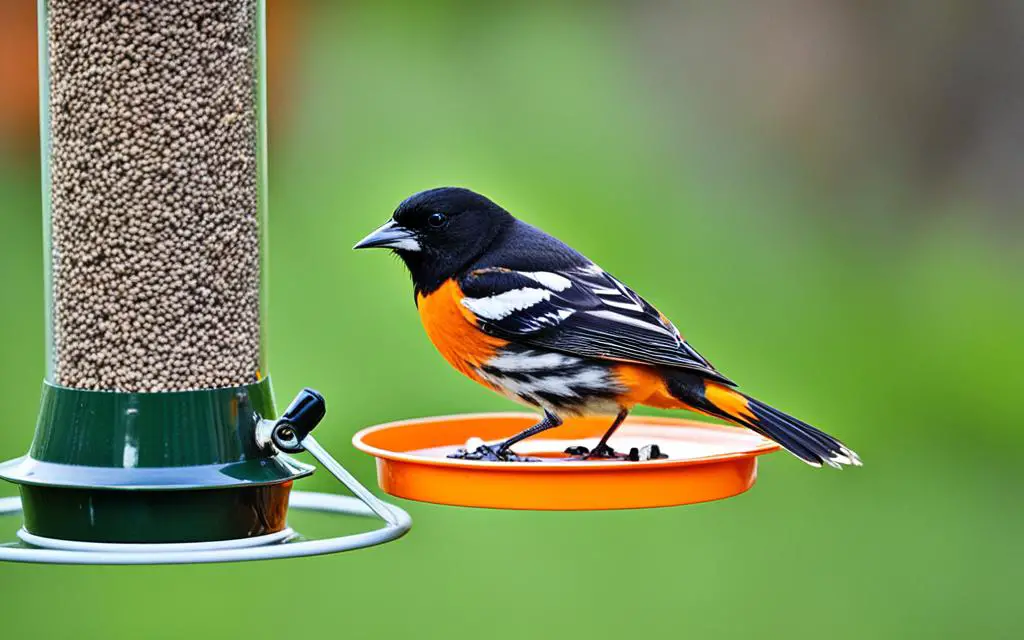
To finalize your decision, distill the insights from reviews resonating with your circumstances. Has a feeder model been celebrated for attracting orioles by numerous enthusiasts in your region? Do personal accounts laud a particular design for its stability and minimal spillage? These pieces of feedback are golden; they can point you to an oriole feeder that has proven its worth in backyards alike to yours. Armed with these considerations and a methodical approach to oriole preferences, choosing the perfect match becomes an exercise in informed decision-making rather than a shot in the dark.
Designing an inviting space for orioles starts with smart feeder placement. The right location not only enhances visibility but also offers protection, ticking all the boxes for attracting these enticing birds. Let’s delve into how you can optimize your feeder’s placement for maximum allure, ensuring that every oriole in the vicinity is tempted to pay a visit.
In the quest to attract orioles, visibility reigns supreme. Your colorful feeder, boasting the vibrant orange color orioles can’t resist, should act as a beacon to these birds as they pass by. To achieve this, consider the hanging location carefully. It should be placed where it’s easily spotted against the backdrop of your garden, ideally from a generous distance. This includes a clear line of sight from the sky and nearby perches. You might even adorn the area with subtle orange ribbons to catch their eye, enhancing the feeder’s attractiveness from afar.
Another key factor in feeder placement is providing a safe haven for your winged guests. Positioning your feeder at a safe distance from other feeders and bustling hotspots grants orioles the peace of mind they need to enjoy their meal. Moreover, situating the feeder near protective cover, such as shrubbery or trees, gives them an escape route from any potential threats. This sense of security is crucial in not just drawing orioles in but also in encouraging them to linger longer and return frequently.
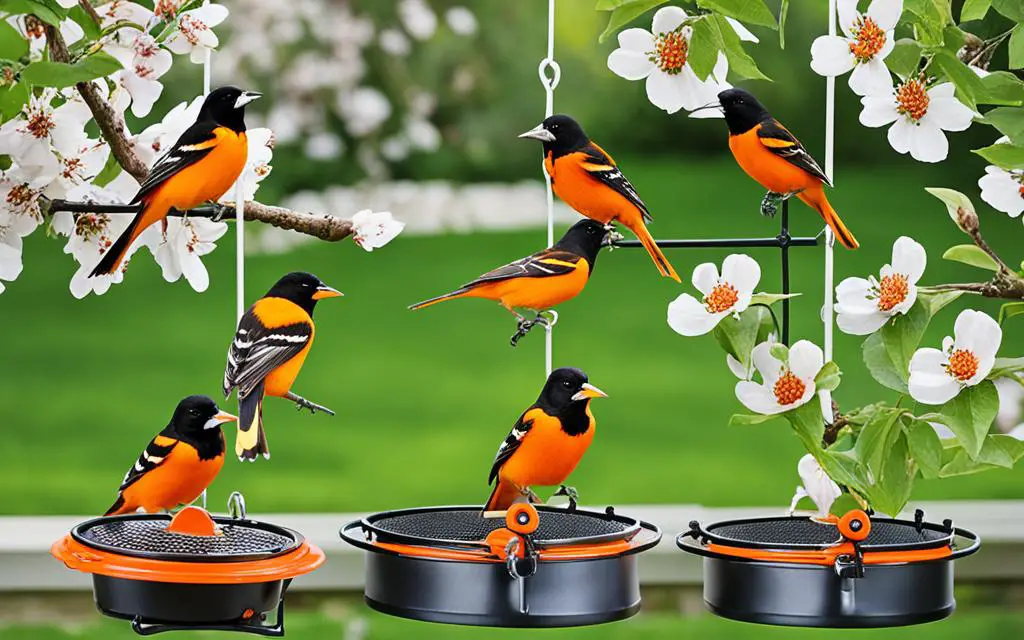
With these tips in mind, you’re well on your way to creating a haven that will have orioles flocking to your backyard. Keep in mind, though, that attracting these elusive beauties is an art as much as it is a science, so feel free to experiment with different placements until you find the sweet spot that works best for your feathered friends and your own birdwatching pleasure.
When it comes to oriole feeders, the materials and construction are not just about aesthetics; they’re about offering a durable sanctuary for these birds that is both reliable and functional, year after year. You’ll want to invest in a feeder that promises longevity and consistency, particularly as orioles are known for returning to dependable sources of nourishment. Ensuring your feeder is tough enough to handle the whims of nature while making maintenance a breeze, factors significantly into the long-term enjoyment of your birdwatching experience.
Selecting a feeder constructed with durability in mind means less replacement over time and more value for your money. Look for materials like robust UV-resistant plastics that resist sun damage, stainless steel for rust-free longevity, and quality polycarbonates that withstand the elements. A sturdy feeder also means that when the winds pick up, you won’t find your bird’s dinner scattered across the lawn—a common frustration for many bird enthusiasts.
Equally essential is a feeder’s weather resistance. The variable climates across the United States demand a feeder that can handle everything from the searing sun of Arizona to the unrelenting dampness of coastal Maine. Look for labels like ‘weatherproof’ or ‘all-weather’ as indicators of resilient construction. Be mindful of features that keep contents dry, such as feeders with overhangs or roof-like structures that shield against rain, ensuring seeds, nectar, or jelly stay contaminant-free and leakproof.
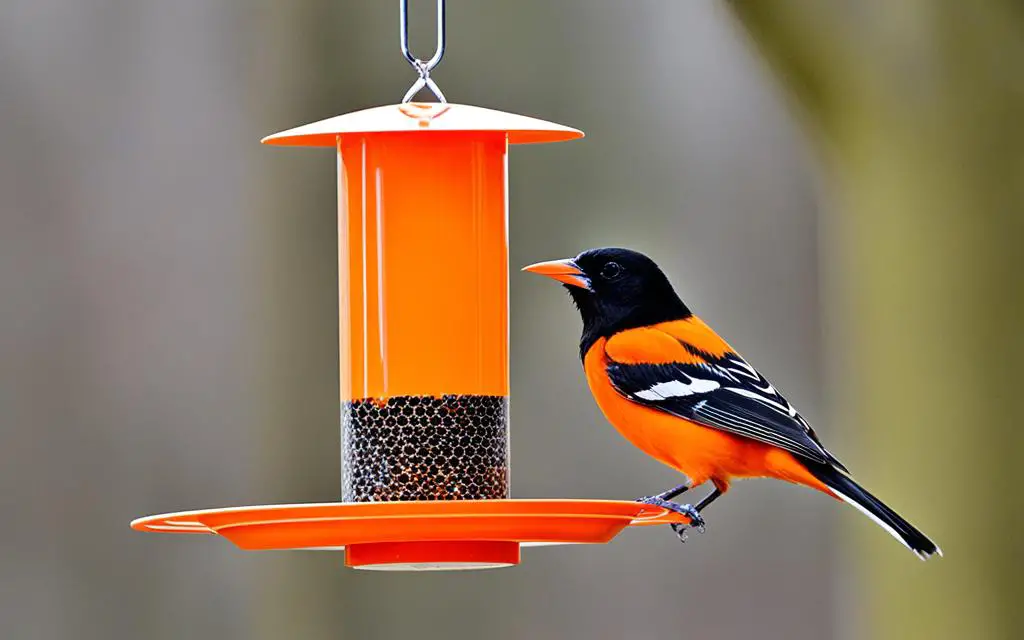
As you make your choice, consider the day-to-day usability of the feeder—easy to clean options not only benefit the birds’ health but also save you time. Some models are even constructed to be dishwasher safe, and this convenient feature simplifies upkeep, making it more likely that the feeder remains pristine and inviting for orioles and a joy rather than a chore for you to maintain.
| Feature | Benefits | Considerations |
|---|---|---|
| UV-resistant Plastic | Prevents color fading and degradation from sun exposure | Look for polycarbonate materials for maximum UV protection |
| Stainless Steel Elements | Rust-free durability that endures through wet conditions | Check if the material is marine-grade for optimal resilience |
| All-Weather Label | Assurance against a wide range of weather conditions | Verify if the feeder has protective features like roofs or overhangs |
| Dishwasher Safe | Allows for hygienic and hassle-free cleaning | Ensure that no feeder parts will warp or deteriorate in the dishwasher |
| Leakproof Design | Keeps nectar from leaking and attracting unwanted pests | Feeder should have sealed joints or gaskets to ensure no leakage |
Keep these considerations in mind as you select your oriole feeder, and you’ll enhance your chances of turning your backyard into a favorite stopover for these brilliant birds every season. With the right combination of durability, easy maintenance, and weather resistance, expect to enjoy the company of orioles for many springs to come.
Inviting the vibrant oriole to your oriole feeder station is just the beginning; keeping these colorful visitors returning is a feat that hinges on keeping feeders clean. To provide a safe haven for these birds, it is essential to establish a routine of regular upkeep. After all, the wellness of orioles, and the sustainability of their presence in your garden, are directly influenced by the cleanliness of their feeding environment.
Without doubt, meticulously maintained feeders are less likely to harbor diseases that can rapidly spread amongst the oriole population. A poorly kept feeder becomes a vessel for pathogens, inserting risk into the very source of sustenance for these birds. Your vigilance in feeder maintenance is a guardian against such threats, preserving the charm and health of your avian guests.
Equally important in the diligent care of your oriole feeders is the prevention of spoilage. The sugary allure of nectar and jelly, while a feast for orioles, is an open invitation to mold growth and pest attraction when neglected. Oriole delight can quickly turn into oriole disappointment if the sweet provisions morph into a source of contamination. It is your role to ensure that such spoilage is preempted through vigilant feeder oversight.
To aid in this crucial aspect of oriole care, here are a few guidelines to incorporate into your feeder maintenance routine:
| Task | Frequency | Benefits |
|---|---|---|
| Cleaning with a mild soap solution | Every time the feeder is refilled | Prevents mold and disease, maintains feeder aesthetics |
| Inspecting for and removing mold or debris | Daily | Ensures the health and safety of feeding orioles |
| Refreshing nectar and jelly | Every 1-3 days, or as needed | Avoids spoilage and keeps orioles satisfied with fresh offerings |
| Check for and remedy leakages | Weekly | Minimizes attraction of pests, prevents waste of feeding substances |
Committing to these tasks not only creates a reliable oriole feeder station but also crystalizes your backyard as a beacon of nourishment and reliability in the orioles’ flight path.
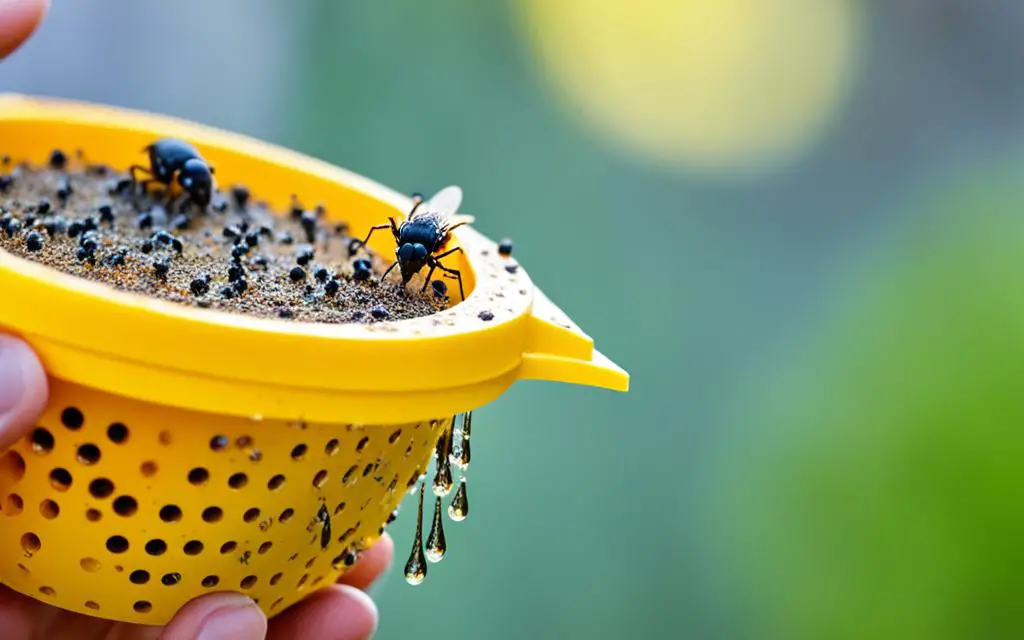
Your engagement in these maintenance practices underscores your dedication to the avian cause. By providing an impeccably clean and consistently replenished oriole feeder station, you forge a sanctuary where orioles thrive and gratitude is sung in their melodic tones. Take pride in this call to action—your contribution to the grand orchestra of nature.
Attracting orioles to your backyard isn’t just about providing food—it’s also about how you present it. When choosing your oriole feeders, focusing on designs that facilitate easy, comfortable dining, and offer protection from pesky invaders will keep these beautiful birds coming back season after season. Let’s explore the key features that make a feeder truly oriole-friendly.
Unlike their hummingbird relatives, orioles don’t possess the ability to hover. Their larger size necessitates perches for them to rest while they refuel. A feeder with sturdy perches not only invites orioles to stay and eat but also allows for better visibility for you to enjoy their presence. Choosing a feeder type that aligns with the oriole’s feeding behavior ensures that your feathered guests can indulge in their meals without toppling the feeder or causing a messy spillage in your oasis.
Your oriole food offerings will undoubtedly attract other critters if left unprotected. Opt for feeders equipped with ant guards and bee guards to discourage these insects from contaminating the sweet rewards meant for your orioles. And when it comes to bigger adversaries, a squirrel-proof design is invaluable. Effective guards prevent these clever creatures from gaining access to the feeder’s contents, ensuring that orioles have an exclusive and uninterrupted dining experience in your backyard retreat.
Investing in top rated oriole feeders can significantly increase your chances of hosting these feathered friends in your backyard. Oriole enthusiasts often emphasize specific oriole feeder features to consider when aiming to attract orioles. Based on widespread consumer feedback, features such as multiple feeding options, durability, and integrated pest prevention measures regularly receive high marks. Consequently, seasoned birders and newcomers alike turn to these real-world accounts to find authoritative guidance on the feeders that will best serve their needs.
Understanding the key attributes that orioles look for in a feeder can lead you to models that cater perfectly to their preferences. For instance, feeders that offer separate compartments for nectar, jelly, and fruit tend to be more popular among these beautiful birds for providing a well-rounded diet. Moreover, feedback often highlights appreciation for feeders made from materials that can weather the seasons without succumbing to the elements, ensuring that the orioles have a consistent food source year after year.
In your search for the ideal feeder, you’ll likely encounter reviews from bird lovers who’ve witnessed a substantial increase in oriole visits due to specific feeder characteristics. Whether it’s an easy-to-clean design that promotes hygienic dining, or the striking orange hue that grabs the birds’ attention, these personal testimonials offer a window into the features that actual orioles find most appealing.
Let’s take a look at a comparative table that showcases the feeders receiving the best reviews, along with the attributes that make them stand out:
| Feeder Name | Feeding Options | Durability | Pest Prevention | User Rating |
|---|---|---|---|---|
| Sunny Orchard Oriole Haven | Nectar, Jelly, Fruit | Weather-resistant plastic | Ant moat and bee guards | 4.8 stars |
| Birds’ Banquet Premium Feeder | Nectar, Jelly compartments | UV-resistant polycarbonate | Bee guards | 4.5 stars |
| Feathery Fruits Nest Feeder | Fruit skewers, Nectar basin | Stainless steel build | Protected fruit holders | 4.7 stars |
These feeders not only meet the multifaceted dietary needs of orioles but also incorporate features designed to enhance the feeding experience for both the birds and the birdwatchers. Trustworthy consumer reviews can be invaluable in steering you toward a purchase that promises to bring a lively oriole congregation into your view. You can take comfort in knowing that the feeders you choose come highly recommended by a community of like-minded birding enthusiasts.
If you are ready to purchase your own Oriole bird feeder, let me recommend the Oriole Bird Feeder, Double-Cup Jelly Oriole Feeder with Pegs for Orange Halves (Orange). This is a great Oriole feeder for any location in your backyard!
Your journey towards attracting orioles to your backyard is within reach when you select the ideal oriole feeder. Armed with an understanding of local species-specific behaviors and the different oriole feeder types, you’re well-equipped to make the right choices for your avian visitors. Remember, a colorful feeder, particularly one with the orange color that orioles can’t resist, can be the beacon that draws these beauties to your garden oasis. But the color alone isn’t enough—appropriate feeder models providing durability, easy maintenance, and protective features are equally vital for a thriving oriole hotspot.
Strategic placement plays a pivotal role in attracting orioles, enhancing the visibility of your feeder while ensuring a safe habitat for these striking birds. Visual cues such as an eye-catching image of a Scott’s oriole can help guide these melodious creatures to their new favorite dining spot. As you select your feeders, keep in mind the goal of creating an inviting setting that appeals directly to the proclivities of these unique birds.
In the end, creating a haven for orioles comes down to a synergy of thoughtful preparations and attentiveness to their preferences. By choosing an oriole feeder that ticks all the boxes—offering a variety of feed like nectar, jelly, and fruit, ensuring accessibility and defense against pests, and presenting it all in a durable construction—you elevate your chances of witnessing the radiant flutter of orioles around your home. The reward of their delightful company is a testament to the care and effort invested in turning your backyard into their preferred retreat.

My name is Shane Warren, the author behind Your Bird Buddy – your ultimate guide to the wonderful world of birds! Unleash your inner avian explorer as we delve into a vibrant library of knowledge dedicated to all things feathered. From learning about diverse bird species from across the globe to understanding their captivating habitats and behaviors, I’m here to fuel your passion for these magnificent creatures. Not only that, but I also provide valuable insights on being a responsible and informed pet bird owner. Join our vibrant community and let’s celebrate the feathered wonders of the world together – one chirp at a time. And be sure to join our Your Bird Buddy Community over on Facebook!